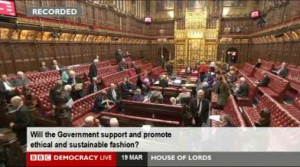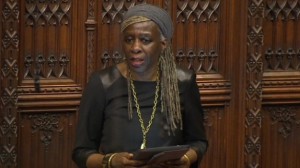
>> Read here if you’re interested in the 2011 question time insights.
Other than in 2011, where it really was about what the importance of the topic was in general terms and to the government in particular, this time a few much clearer points could be identified in each of the speakers interventions. Unsurprisingly these usually revolved around a) Made in Britain b) intransparent supply chains, c) government support for sustainable fashion either through SME support, or consumer education or pressure on larger businesses.
The following is a summary of the different statements made in the different 4-minutes-interventions, documented both on video and in the protocol:

Part 1 – factual information given as a background (mostly by Baroness Lola Young, but a few others contributed with additional facts):
- The estimated amount spent on clothing in the UK in 2011 was £43.9 billion.
- The estimated value of UK-manufactured clothing and textiles in the UK was £8.1 billion in 2011.
- The he overall estimated export value of UK clothing and textiles was £7.3 billion.
- In 2009, the United Kingdom fashion industry was estimated to contribute more than £20 billion to our economy and to support more than 800,000 jobs and therefore is substantial in its role for the national economy.
- About 90% of the clothing consumed in the UK is imported.
- About a third of the clothing we no longer need ends up in landfill-that is, around 350,000 tonnes or an estimated £140 million-worth of used clothes.
- On average, the global water footprint of a UK household’s clothing exceeds 200,000 litres a year (enough to fill more than 1,000 bathtubs to capacity).
- High-profile “heritage” British brands, such as Burberry, Aquascutum and Crombie, is often all or mostly made outside the UK.
- Fashion and textiles is one of the top 20 productive sectors in the UK.
- Uzbek cotton – unfamously famouse for the country’s use of child and slave labour during harvestseason – accounts for 10% of the world’s harvest, ranking third in the world.
- WRAP and Defra were presented with the Global Leadership Award in Sustainable Apparel by the Swedish Sustainable Fashion Academy in Stockholm in February 2013.
Part 2 – oppinions, questions and demands by the peers towards the minister:
- The fashion industry and its use of overly young, seemingly annorexic girls and women. So far not part of any ethical fashion agenda, and a nearly-forgotten-about topic, this needs to be part of the problems to be tackeled (Lord Patten).
- Non-compliance and badly monitored supply chains are nothing peculiar to the fashion industry – this included child labour. Rather than singling fashion out for one reason or another, there needs to be overall more pressure on companies to comply with legal minimum requirements, and preferably with best-practise. (Lord Patten)
- The following of Lord Patten’s words are worth quoting directly: “
a very good tool is to hand in the condign punishments available under the UK's Bribery Act and bribery legislation. UK companies which permit their supply chains to bribe and act in a corrupt way are those which do not treat their workforces very well. We should ensure that the Bribery Act provisions are implemented the whole way down the line. That would add to health and safety, and to better pay and conditions.“. - Both, business as well as consumers have a role to play. The question now is how to get the two to collaborate, rather than one side playing the ball back to the other and vice versa. (Several statements)
- Another statement worth quoting as is, this time by Lord Stone of Blackheath:
"A friend who has a new factory in the UK tells me that some awful UK factories bring in people at night to work the machines. They are paid by the illegal "cabbage" system. They have no right-to-work documentation to prove they are legitimate workers. We need this stopped so that ethical trading companies with audited compliance are not put at a disadvantage. As well as criticising other countries, we need to enforce ethical trading here in the UK." - In November 2012, The business secretary promised government support to breathe new life into UK textile manufacturing as a study revealed that the cost gap with Asia is narrowing. But – what has since become of this initiative? And what is being done to help SMEs (not only fashion and textiles, but evidently including those) tackle the issues they have in the current economic climate?
- Support for SMEs (beyond fashion, in fact) is needed to lead the way for 2 reasons. A) because they are the most likely to actually know what they are doing, and having the commitment to ‘do the right thing’, and B) because they’re at the same time those that have a hard time in the current consumer climate, not the least because they can’t scale as easily as the big one, and C) because they make up nearly 80% of the nation’s GDP.
Conclusion – the most relevant, outstanding points
From where I stand, most of what has been raised in the discussion clearly shows the relative inexperiences of the peers with the topic of sustainability and the fashion industry. This said, the following are points worth noticing:
- There is a recognition that sustainability – also in fashion and textiles – is both, a business as much as consumer issue. And that education as well as pressure on both elements need to be exercised.
- The fact that the UK Bribary Act was mentioned as means to put pressure on non-compliant companies is of relevance. Not only for the fact that the Act is considered a good means to achieve compliance with labour and human-rights standards, but also for the recognition that this type of legislation with international jurisdiction might be an important puzzle piece in the overall picture.
- Further, while ‘Made in Britain’ was lauded and seen as important to support the national industry, it was also clearly said that the ‘Made in Britain’ alone may not mean much, and that as much as prosecuting overseas non-compliance cases, and equally sever attitude and commitment need to be in place for UK based manufacturers that try to circumvene the law and their related obligations.
I whole heartedly agree with this oppinion. -
In November 2012, the Business Secretary announced – seconded by the likes of Paul Smith – government support for the UK textile manufacturing industry. However, it has since gone very quiet around this issue. The peers rightly raised the question of what is going on, and if there had been any further steps since.
The reality though is, and always has been, that such support in essence is limited to what could be called ’emotional support and goodwill’. Indeed, already at the press and industry event in November it became apparent that such a revival would essentially have to be lead by the industry themselves, and that no cash (or other) incentives could be expected anytimes soon.
If anything, any incentives would be targetting any type of UK based manufacturing, rather then the textile and fashion industry exclusively.

